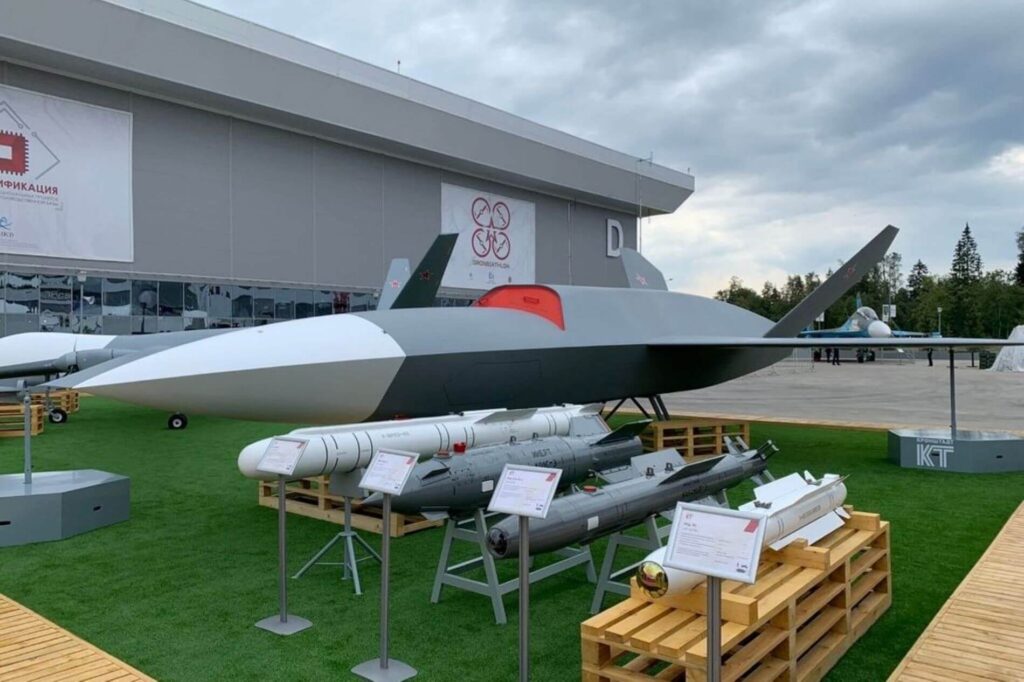Unmanned aerial vehicles (UAVs) have become a prominent part of large military expos in recent years. Russian Army-2020, which took place at the end of August 2020, was not an exception. One of many mockups presented there was introduced as the “loyal wingman”: a development, closely resembling the latest projects by some American, European and Oceanian companies. Let’s take a closer look at it.
The unofficial term “loyal wingman” refers to a small or medium combat drone intended to accompany manned aircraft into battle. Such drones are set to be one of the staple of the coming generation of fighter jets, and an upgrade to the older ones. A number of them are being developed around the world, including Kratos XQ-58 Valkyrie, Sierra 5GAT, Boeing ATS, and several others.
Russian media often attributed the definition to Sukhoi S-70 Okhotnik, which was shown flying along Su-57 fifth generation fighter jet and was said to be designed to accompany it with ground attack and reconnaissance capabilities. Questions can be raised in regards to such an attribution, as Okhotnik neither is set to have anti-air capabilities, nor to be fully or even partially controlled by an artificial intelligence (AI): two often cited features of “loyal wingmen”.
Therefore, Grom can be considered as either the second or the first Russian attempt at the concept, depending on how you count. Yet there is at least visual basis for attribution this time. The aircraft was publicized as the “Russian answer to Valkyrie”, Kratos drone flight tested in early 2019, and looks quite a bit like one.
The comparison was not avoided neither by Russian media, nor by the manufacturing company Kronshtadt. “The outward similarity to “Valkyrie” is definitely there, but, if you look at the project, the difference becomes obvious. The Russian drone is bigger, but most importantly, it has a much broader spectrum of capabilities,” Nikolai Dolzhenkov, the chief engineer at Kronshtadt, is quoted by Russian news site Utro.ru.
The difference in the size is definitely there. Grom is described as going to have a length of 13.8 meters and a wingspan of 10 meters, as opposed to 8.8 meters and 6.7 meters of the Valkyrie. Grom’s maximum take-off weight is set to be 7 tons (2.5 times that of Valkyrie) and a payload capacity – 2 tons (4 times more than Valkyrie).
As for the “much broader spectrum of capabilities”, Dolzhenkov describes Grom as “shaped to perform missions of a bomber”: breaking through anti-air defenses, attacking ground targets and working in conjunction with other aircraft. Its “fighter-like” functions are supposed to be secondary, “as opposed to Valkyrie”.
The engineer seems to be referring to Valkyrie’s much-publicized, but never confirmed air-to-air performance, a problem found in almost every journalistic article on the topic. While the intention to arm XQ-58 with air-to-air missiles was never denied and remains a possibility, its primary armament, confirmed by Kratos, remains an assortment of precision-guided bombs. Which puts Grom into the exact same category.
Another problem is even more evident. The most difficult, and the most groundbreaking feature of any “loyal wingman” is an ability to use advanced AI systems, and team them both amongst themselves and with human pilots. Have Raider experiments by Lockheed Martin and MUT tests by Airbus, for example, were aimed at researching and demonstrating a presence of algorithms and interfaces adequate for the task. Further development of such algorithms is one of the main aims of the U.S. Skyborg program as well.
There are reports in Russian media that Grom is set to become a testbed for new Russian AI systems, but the information is not confirmed by designers. Instead, a brochure, distributed by Kronshtadt during Army-2020 expo, informs that Grom complex includes an UAV, its armament and ground-based control module which “ensures the functioning of ground personnel, responsible for the control of the UAV”. In other words, AI- controlled Grom is not even in the plans.
Of course, these insights are made with two large assumptions: one is that characteristics of mass-produced Grom will at least resemble the current plans, and another one is that Grom is really in development. While Kronshtadt is relatively successful with their conventional UAVs, their Orion being both the first long-endurance drone and the first combat drone adopted by the Russian air force, they have no experience of working with stealth technology or combat-oriented AI systems. On the other hand, at least several vacancies for programmers with experience in machine-learning are present at their website.
At present, the situation is very unclear. Deadlines for the end of development, production of prototypes or flight testing are not disclosed. Except for a brochure with several round numbers, a mockup (seemingly made of plywood) and a few pathos-filled words from one of the company’s employees, there is not much to go for. Grom might be the Russian response to similar western projects, but it might be a PR-move to piggyback on the slew of news about those projects as well.

